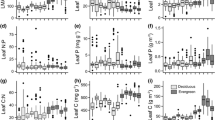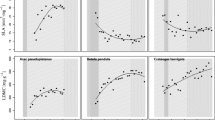Abstract
Nine leaf traits (area, fresh weight, dry weight, volume, density, thickness, specific leaf area (SLA), dry matter content (LDMC), leaf nitrogen content (LNC)) from ten plant species at eight sites in southern mediterranean France were investigated in order to assess their variability along a climatic gradient and their ranking congruency power. After examination of trait correlation patterns, we reduced the nine initial leaf traits to four traits, representative of three correlation groups: allometric traits (dry weight), functional traits (SLA and dry matter percentage) and Leaf Thickness. We analysed the variability of these four leaf traits at species and site level. We observed that between species variation (between 64.5 for SLA and 91% for LDMC) is higher than within species variation. Allowing a good congruency of species ranking assessed by spearman rank correlation () and a good reallocation of individuals to species by discriminant analysis. A site level variability (between 0.7% for Dry weight and 6.9% for SLA) was identified and environmental parameters (altitude, temperature, precipitation, nitrogen, pH) were considered as probable control factors. We found significant correlation between SLA, LDMC and the average minimum temperature (respectively r=0.87 and r=-0,9) and no correlation for the other traits or environmental parameters. Furthermore, we conclude that two leaf traits appear to be central in describing species: specific leaf area (SLA), percentage of dry matter (LDMC. While, SLA and LDMC are strongly correlated, LDMC appears to be less variable than SLA. According to our results the Dry Matter Content (or its reversal Leaf Water Content) appears the best leaf trait to be quantified for plant functional screening. Leaf thickness appeared to be rather uncorrelated with other leaf traits and show no environmental contingency; its variability could not have been explained in this study. Further studies should focus on this trait.
Similar content being viewed by others
References
Aubert G. 1978. Méthodes d'analyses des sols, pp. 90–97. Centre Régional de Documentation Pédagogique de Marseille.
Bertin N., Tchamitchian M., Baldet P., Devaux C., Brunel B. and Gary C. 1999. Contribution of carbohydrate pools to the variation in leaf mass per area within a tomato plant. New Phytologist 143: 53–62.
Bond W.J. 1997. Functional types for predicting changes in biodiversity: a case study in Cape fynbos. In: Smith T.M., Shugart H.H. and Woodward F.I. (eds), Plant functional types-their relevance to ecosystem properties and global change, pp. 174–194. Cambridge University Press, Cambridge, UK.
Box E.O. 1982. Life-form composition of Mediterranean terrestrial vegetation in relation to climatic factors. Ecologia Mediterranea 8: 173–181.
Box E.O. 1995. Factors determining distributions of tree species and plant functional types. Vegetatio 121: 101–116.
Burrough P.A. 1986. Priniciples of geographical information systems for land resources assessment. Monographs on soil and re-sources survey No. 12. Oxford University Press, Oxford, UK.
Cornelissen J.H.C., Castro-Díez P. and Hunt R. 1996. Seedling growth, allocation and leaf attributes in a wide range of woody plant species and types. Journal of Ecology 84: 755–765.
Craine J.M., Froehle J., Tilman D.G., Wedin D.A. and Chapin F.S. III. 2001. The relationships among root and leaf traits of 76 grassland species and relative abundance along fertility and disturbance gradients. Oikos 93: 274–285.
Díaz S., Cabido M. 1997. Plant functional types and ecosystem function in relation to global change. Journal of Vegetation Science 8: 463–474.
Dijkstra P. and Lambers H. 1989. Analysis of specific leaf area and photosynthesis of two inbred lines of Plantago major in relative growth rate. New Phytologist 113: 283–290.
Escudero A., Manzano J.J. and Del Arco J.M. 1987. Nitrogen concentrations in the leaves of different Mediterranean woody species. Ecologia Mediterranea 13 (3): 11–17.
Evans R.D. and Ehleringer J.R. 1994. Water and nitrogen dynamics in an arid woodland. Oecologia 99: 233–242.
Field C. and Mooney H.A. 1986. The photosynthesis-nitrogen relationship in wild plants. In: Givnish T.J. (ed.), On the Economy of Plant Form and Function. Cambridge University Press, Cambridge, UK, pp. 25–55.
Filella I. and Penuelas J. 1999. Altitudinal differences in UV absorbance, UV reflectance and related morphological traits of Quercus ilex and Rhododendron ferrugineum in the Mediterranean region. Plant Ecology 145 (1): 157–165.
Garnier E. 1992. Growth analysis of congeneric annual and perennial grass species. Journal of Ecology 80: 665–675.
Garnier E. and Laurent G. 1994. Leaf anatomy, specific mass and water content in congeneric annual and perennial grass species. New Phytologist 128: 725–736.
Garnier E., Cordonnier P., Guillerm J.-L. and Sonié L. 1997. Specific leaf area and leaf nitrogen concentration in annual and perennial grass species growing in Mediterranean old-fields. Oecologia 111: 490–498.
Garnier E., Bellmann S., Debain P., Berthelier P., Ducour D., Roumet C. and Navas M.-L. 2001. Consistency of species ranking based on fuctional leaf traits. New Phytologist, 152: 69–83.
Gratani L. and Crescente M.F. 1997. Phenology and leaf adaptive strategies of Mediterranean maquis plants. Ecologia Mediterranea 23(3/4): 11–19.
Grime J.P., Thompson K., Hunt R., Hodgson J.G., Cornelissen J.H.C., Rorison I.H, Hendry G.A.F., Ashenden T.W., Askew A.P., Band S.R., Booth R.E., Bossard C.C., Campbell B.D., Cooper J.E.L., Davison A.W., Gupta P.L., Hall W., Hand D.W., Hannah M.A., Hillier S.H., Hodkinson D.J., Jalili A., Liu Z., Mackey N., Matthews N., Mowforth M.A., Neal A.M., Reader R.J., Reiling K., Ross-Fraser W., Spencer P.E., Sutton F., Tasker D.E., Thorpe P.C. and Whitehouse J. 1997. Integrated screening validates primary axes of specialisation in plants. Oikos 79: 259–281.
Huante P., Rincón E. and Acosta I. 1995. Nutrient availability and growth rate of 34 woody species from a tropical deciduous forest in Mexico. Functional Ecology 9: 49–858.
Körner C.h. 1989. The nutritional status of plants from high altitudes. A worldwide comparison. Oecologia 81: 379–391.
Lusk C.H., Contreras O. and Figueroa J. 1997. Growth, biomass allocation and plant nitrogen concentration in Chilean temperate rainforest tree seedlings: effects of nutrient availability. Oecologia 109: 49–58.
McIntyre S., Díaz S., Lavorel S. and Cramer W. 1999. Plant functional types and disturbance dynamics-Introduction. J. Veg. Sci. 10: 604–608.
McLachlan G.J. 1992. Discriminant analysis and statistical pattern recognition. J. Wiley, New York, New York, USA.
Meziane D. and Shipley B. 1999. Interacting Determinants of Interspecific Relative Growth Rate: Constancy and Change under Differing Conditions of Light and Nutrient Supply. Functional Ecology 13: 611–622.
Mooney H.A., Ferrar P.J. and Slatyer R.O. 1978. Photosynthetic capacity and carbon allocation patterns in diverse growth forms of Eucalyptus. Oecologia (Berl.) 36: 103–111.
Niinemets U. 2001. Global-scale climatic controls of leaf dry mass per area, density, and thickness in trees and shrubs. Ecology 82(2): 453–469.
Pierce L.L., Running S.W. and Walker J. 1994. Regional scale relationships of leaf area index to specific leaf area and leaf nitrogen content. Ecological Applications 4(2): 313–321.
Poorter H. and Bergkotte M. 1992. Chemical composition of 24 wild species differing in relative growth rate. Plant, Cell and Environment 15: 221–229.
Poorter H. and Evans J.R. 1998. Photosynthetic nitrogen-use efficiency of species that differ inherently in specific leaf area. Oecologia 116: 26–37.
Poorter H., Garnier E. 1999. Ecological significance of inherent variation in relative growth rate. In: Pugnaire F.I. and Valladores F. (eds), Handbook of functional plant ecology, pp 81–120. Marcel Dekker Inc., New York, New York, USA.
Reich P.B. and Walters M.B. 1994. Photosynthesis-nitrogen relations in Amazonian tree species. (II) Variation in nitrogen vis-à-vis specific leaf area influences mass-and area-based expressions. Oecologia 97: 73–81.
Reich P.B., Walters M.B. and Ellsworth D.S. 1992. Leaf life-span in relation to leaf, plant, and stand characteristics among diverse ecosystems. Ecological Monographs 62(3): 365–392.
Reich P.B., Walters M.B., Ellsworth D.S., Vose J.M., Volin J.C., Gresham C. and Bowman W.D. 1998. Relationships of leaf dark respiration to leaf nitrogen, specific leaf area and leaf life-span: a test across biomes and functional groups. Oecologia 114: 471–482.
Sabaté S., Sala A. and Gracia C.A. 1995. Nutrient content in Quer-cus ilex canopies: seasonal and spatial variation within a catchment. Plant and Soil 168-169: 297–304.
Shipley B. 1995. Structured interspecific determinants of specific leaf area in 34 species of herbaceous angiosperms. Functional Ecology 9: 312–319.
Thompson K., Parkinson J.A., Band S.R. and Spencer R.E. 1997. A comparative study of leaf nutrient concentrations in a regional herbaceous flora. New Phytologist 136: 679–689.
Weiher E., van der Werf A., Thompson K., Roderick M., Garnier E. and Eriksson O. 1999. Challenging Theophrastus: A common core list of plant traits for functional ecology. Journal of Vegetation Science. in press.
Westoby M. 1998. A leaf-height-seed (LHS) plant ecology strategy scheme. Plant and Soil 199: 213–227.
Wilson P.J., Thompson K. and Hodgson J.G. 1999. Specific leaf area and leaf dry matter content as alternative predictors of plant strategies. New Phytologist 143: 155–162.
Witkowski E.T.F. and Lamont B.B. 1991. Leaf specific mass confounds leaf density and thickness. Oecologia 88: 486–493.
Woodard F.I. and Kelly C.K. 1997. Plant functional types: towards a definition by environmental constraints. In: Smith T.M., Shugart H.H. and Woodward F.I. (eds), Plant functional types-their relevance to ecosystem properties and global change, pp. 47–65. Cambridge University Press, Cambridge, UK.
Wright I.J. and Westoby M. 2001. Understanding seedling growth relationships through specific leaf area and leaf nitrogen concentration: generalisations across growth forms and growth irradiance. Oecologia 127: 21–29.
Author information
Authors and Affiliations
Corresponding author
Rights and permissions
About this article
Cite this article
Roche, P., Díaz-Burlinson, N. & Gachet, S. Congruency analysis of species ranking based on leaf traits: which traits are the more reliable?. Plant Ecology 174, 37–48 (2004). https://doi.org/10.1023/B:VEGE.0000046056.94523.57
Issue Date:
DOI: https://doi.org/10.1023/B:VEGE.0000046056.94523.57




